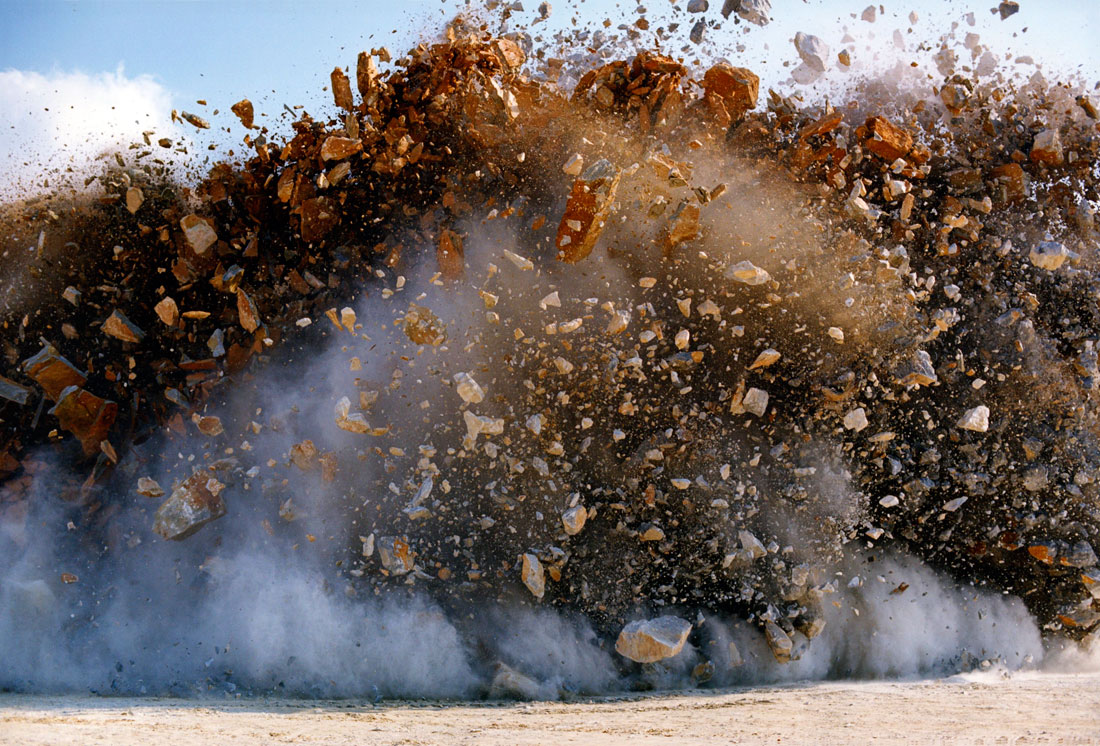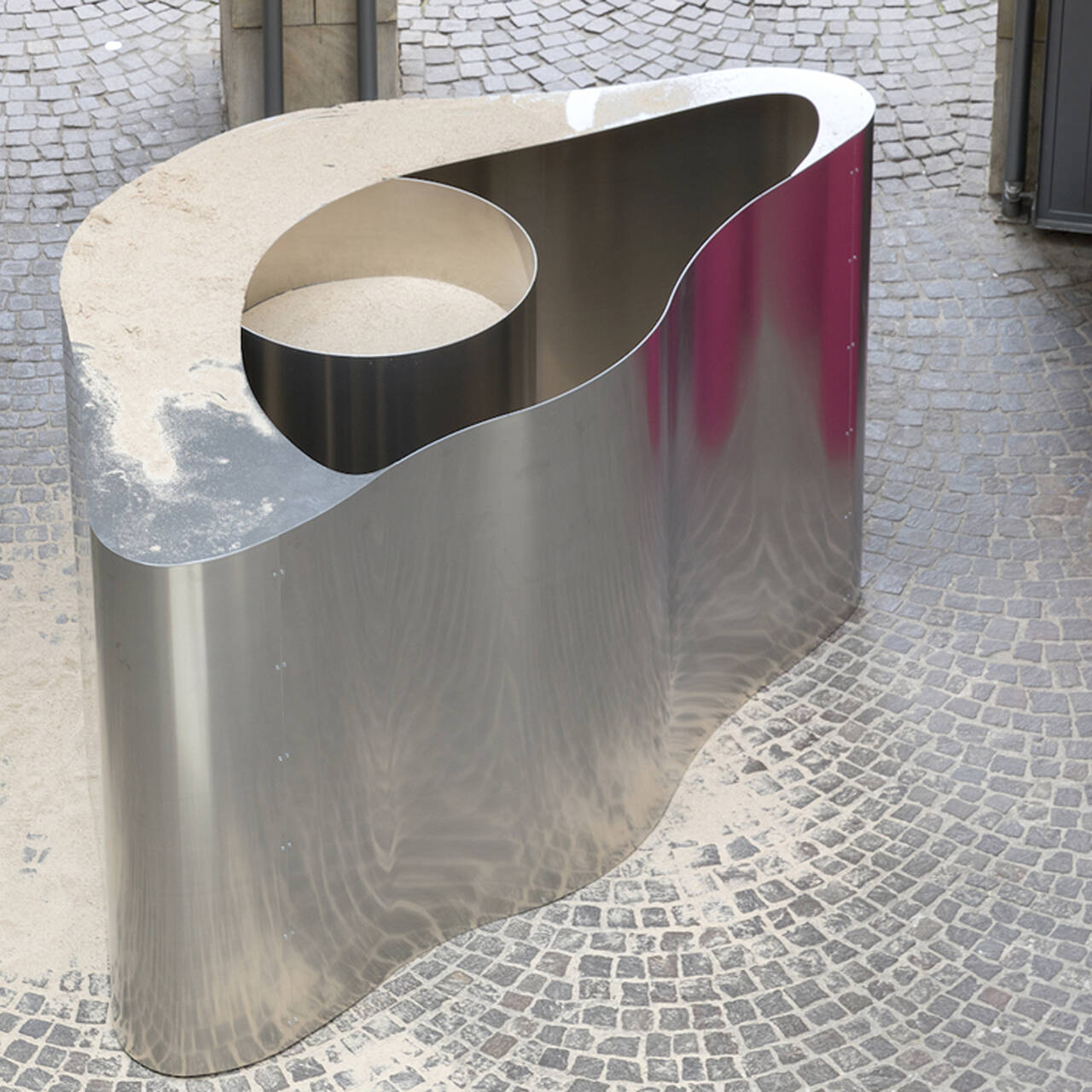Brutal destruction or eruptive innovation – the theme of the explosion takes a wide variety of forms in art history.
In the rotunda of the SCHIRN Peter Halley applied the repeated theme of an explosion to the entire spread of glass windows. What is it that draws Halley and other artists to explosions – the sudden release of huge quantities of energy? Is it brutal destruction or eruptive innovation? The SCHIRN MAG went on the hunt for explosions in art.
ROY LICHTENSTEIN
Lichtenstein began using representations of explosions from war comics for his art in 1962. The artist was interested in how the comic, which at that time was considered commercial and somewhat beyond the pale of intellectuals, presented the dynamics of explosions. However, the 1960s was also a time in which many people were preoccupied by the risk of a nuclear war – 1962 was the year of the Bay of Pigs crisis in Cuba. In some images of explosion, Lichtenstein also used onomatopoeia, which is standard in comics. These works have titles like “Varoom!” or “Whaam!”. In “Whaam!” the explosion is presented in connection with acts of war and war planes. From 1964 onwards Lichtenstein also created sculptures with themes taken from his images of explosions.

Roy Lichtenstein, Explosion No.1, 1964, Image via artblogcologne.com
ANDY WARHOL
Andy Warhol tackled the subject of the explosion in various ways. His series “Death and Disaster” includes the work “Atomic Bomb” from the year 1965. It shows newspaper photographs of a mushroom cloud repeated 28 times in black and red. He thus tackled the theme of the Cold War in more direct fashion than his colleague Lichtenstein. A series of multimedia performances, which Warhol created in 1966-7 together with the rock band The Velvet Underground and its singer Nico, bears the name “Exploding Plastic Inevitable”. During the performance the artists bombarded their audience with aggressive music, bright light, psychedelic images and wild dancing. In addition to this, with his 1985 work “Vesuvius” Warhol joined the long line of artists who had depicted the erupting volcano Vesuvius in Italy.

Andy Warhol, Atomic Bomb, 1965, Image via saatchigallery.com
JOHAN CHRISTIAN CLAUSEN DAHL
Warhol was not the only artist to be drawn under the spell of Vesuvius erupting. In the age of Classicism climbing Vesuvius was a must for every visitor to Italy. Norwegian landscape painter Dahl was even fortunate enough to witness the natural spectacle of an eruption himself on his visit to Naples in 1820-1. The sketches he produced at the time he later turned into a series of oil paintings, but in Dahl’s work the explosion of the volcano is not presented as an awe-inspiring natural event. Rather, the painting reflects the burgeoning interest in scientific observation of natural and earth history, which culminated in the establishment of geology as a modern science in its own right.

Johan Christian Clausen Dahl, Der Ausbruch des Vesuv im Dezember 1820, 1826, Image via digitalesammlung.staedelmuseum.de
NAOYA HATAKEYAMA
Japanese photographer Naoya Hatakeyama has been photographing Japan’s limestone quarrying since the early 1980s. He actually grew up near the quarry areas and his father worked in a limestone factory. Since 1995 Hatakeyama has also been photographing the blasting operations close up, and has published them in his “Blast” series. In order to create these risky shots, the artist worked closely with an explosives expert, who calculated precisely where the fragments would fly. The result shows the human capacity to alter nature. Hatakeyama perceives this destruction as something natural. After all, everything changes, even nature: the corals, for example, that lived in the warm equatorial ocean between 200 and 400 million years ago, became limestone and this now becomes concrete.

Naoya Hatakeyama, A BIRD/Blast #130, 2006, Image via pier24.org
VHILS
Portuguese artist Alexandre Farto, whose alias is Vhils, blasts faces onto buildings in cities. First he chisels out a drawing onto the wall of the building, attaches explosives to the open surface, plasters over the whole thing and then triggers the blast. In doing so, he is playing with the concept of vandalism: He wants to destroy in order to create something. He is always aware that his works are generally removed afterwards, but this ephemeral quality is part of the very nature of street art. To him, the explosion – the performance – is more important than the finished image, and he captures it in film. The emergence through the explosion, the sudden transformation of a building wall into an image, determines the impact of the finished work.

Vhils, Hell's Half Acre, Old Vic Tunnel, London, 2010, Image via zeit.de
CAI GUO-QIANG
Chinese artist Cai Guo-Qiang “draws” with explosion and combustion. The emergence of the enormous drawings is in itself a happening, as for example in the Turbine Hall of the Tate Modern in London in 2003. Japanese paper is laid out on the floor as the basis for the image, which Cai Guo-Qiang covers with stencils and with up to 15 different sorts of gunpowder in order to create images through traces of powder and burn marks. The artist lights the fuse and in seconds the work disappears under a huge cloud of smoke. The resulting composition is a combination of planning and chance. In China, explosions are part of everyday life, as Cai Guo-Qiang explains: Every significant social event, be it good or bad – a wedding or a funeral – is accompanied by fireworks.

Cai Guo-Qiang, Mr Ye Who Loves Dragon, 2003, Image via tate.org.uk
LOS CARPINTEROS
The Cuban artist group “Los Carpinteros” has already produced several sculptural freeze-frames of explosions. In 2008, at London’s Hayward Gallery, for example, they created a room full of IKEA furniture being ripped apart by an imaginary explosion. Walls, furniture and debris fly through the air. It is as if time were stopped during the explosion and the visitor can step into this frozen image. The possible interpretations the two artists offer range from the private scenario of a marriage that has broken down to the ever greater proximity of hotbeds of political conflict, from which the “Global North” – the “IKEA world” – is no longer shielded.

Los Carpinteros, Show Room, 2008, Image via mymodernmet.com
PETER HALLEY
Halley has been using the subject of the explosion since as far back as 1983. It can be seen for the first time in his animated video work “Exploding Cell”, which is on display in the SCHIRN. The video shows a cell that is in the process of change – and is filled with gas until it explodes. During the 1980s Halley dealt with the themes of the Cold War and atomic bombs. The exploding cell was originally linked to the negative association of destruction. The theme became a key element in Halley’s oeuvre, although it lost its historical reference and the artist became more and more interested in the symbolic nature of explosiveness. The explosion is in contrast with another important subject in Halley’s oeuvre: geometric shapes. While the geometric forms represent confinement and an unchanging order, the explosion can be read as a symbol of change or transformation.


THE STRONGEST KARMIC CONNECTION
The people who surround us in our childhood impact us, regardless of how those relationships make us feel. Often, they make us seek other and new...

You Get the Picture: On Movement and Substitution in the Work of Lena Henke
The artist LENA HENKE already exhibited in the SCHIRN Rotunda in 2017. What are the secrets of her practice and where can you find her art today?

'Have yourself an experimental Christmas'
Bored of watching the same old Christmas films over and over again? Here are some of our favourite experimental films for the festive season.

MOTHER IS MOTHERING. Lesbian motherhood in art
The role of the mother is often described, but most representations are still based on a heteronormative and patriarchal understanding. What does...

Queercoding in Art and Film: The Portrayal of St. Sebastian
While the sexualised portrayal of Saint Sebastian in Derek Jarman's feature film debut "Sebastiane" initially sparked social controversy in 1976,...

Clubs in crisis: What is the future for club culture?
Great things happen in crises, so they say. But maybe something is getting irretrievably lost. Clubs are not only places to celebrate, but also...